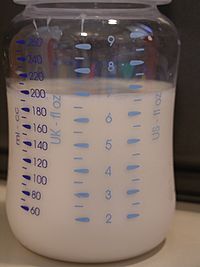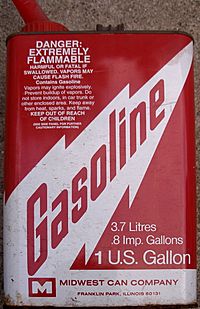Comparison of the Imperial and US customary systems facts for kids
Both the imperial and United States customary systems of measurement derive from earlier English systems used in the Middle Ages, that were the result of a combination of the local Anglo-Saxon units inherited from German tribes and Roman units brought by William the Conqueror after the Norman Conquest of England in 1066.
Having this shared heritage, the two systems are quite similar, but there are differences. The US customary system is based on English systems of the 18th century, while the Imperial system was defined in 1824, after American independence.
Contents
Volume
The main difference is in units of volume. The American system has two gallons: a wet and a dry one. The imperial gallon is bigger than each of these. However, the imperial fluid ounce is slightly smaller than the American one.
| 1 U.S. fluid ounce | = 29.573 529 562 5 mililitres | ≈ 1.041 Imperial fluid ounces |
|---|---|---|
| 1 Imperial fluid ounce | = 28.413 062 5 mililitres | ≈ 0.961 U.S. fluid ounce |
| 1 liquid U.S. gallon | = 3.785 411 784 litres | ≈ 0.833 Imperial gallon |
| 1 Imperial gallon | = 4.546 09 litres | ≈ 1.201 liquid U.S. gallons |
| 1 dry U.S. gallon | = 4.404 842 803 2 litres | ≈ 0.968 Imperial gallon |
| 1 Imperial gallon | = 4.546 09 litres | ≈ 1.032 dry U.S. gallons |
Length
The international yard is exactly 0.9144 metres. This definition was agreed upon by the United States, Canada, the United Kingdom, South Africa, Australia and New Zealand in 1959. However, the United States continued to use its old length units for surveying purposes. The US survey foot is exactly 36/39.37 metre.
Weight
Another difference is in units of mass. In Britain people often use the stone. One stone is 14 pounds. Eight stones are one hundredweight (112 lb). Twenty hundredweights are one ton. So one British ton is 2240 pounds. It is very close to the tonne of the metric system.
In the United States people do not use the stone. They usually use a hundredweight of 100 pounds. This hundredweight is also called a short hundredweight. Twenty short hundredweights are one short ton. The British hundredweight is also called the long hundredweight and the Britsh ton is also called the long ton.
Notes:
|
||||
| Unit name | Imperial measures | US fluid measures | US dry measures | Metric measures |
|---|---|---|---|---|
fluid ounces |
||||
| Imperial fluid ounce (fl oz) |
≡ 1 fl oz |
≈ 0.96075994040 fl oz |
≡ 28.4130625 mL |
|
| US fluid ounce (customary) (fl oz) |
≈ 1.04084273079 fl oz |
≡ 1 fl oz |
≡ 29.5735295625 mL |
|
| US fluid ounce (food nutrition labelling) (fl oz) (food) |
≈ 1.05585239184 fl oz |
≈ 1.01442068106 fl oz |
≡ 30 mL |
|
pints |
||||
| Imperial pint (pt) |
≡ 20 fl oz |
≈ 19.2151988081 fl oz |
≈ 1.03205674349 US dry pt |
≡ 568.26125 mL |
| US liquid pint (pt) |
≈ 16.6534836926 imp fl oz |
≡ 16 US fl oz |
≈ 0.859367007375 US dry pt |
≡ 473.176473 mL |
| US dry pint (pt) |
≈ 19.3787794384 imp fl oz |
≈ 18.6183549784 US fl oz |
≡ 1 dry pint |
≡ 550.6104713575 mL |
quarts |
||||
| Imperial quart (qt) |
≡ 40 imp fl oz |
≈ 38.4303976162 US fl oz |
≈ 1.03205674349 US dry qt |
≡ 1136.5225 mL |
| US liquid quart (qt) |
≈ 33.3069673852 imp fl oz |
≡ 32 US fl oz |
≈ 0.859367007375 US dry qt |
≡ 946.352946 mL |
| US dry quart (qt) |
≈ 38.7575588768 imp fl oz |
≈ 37.2367099567 US fl oz |
≡ 1 US dry qt |
≡ 1101.220942715 mL |
gallons |
||||
| Imperial gallon (gal) |
≡ 160 imp fl oz |
≈ 153.721590465 US fl oz |
≈ 4.12822697395 US dry qt |
≡ 4546.09 mL |
| US liquid gallon (gal) |
≈ 133.227869541 imp fl oz |
≡ 128 US fl oz |
≈ 3.437468029501 US dry qt |
≡ 3785.411784 mL |
| US dry gallon (gal) |
≈ 155.030235507 imp fl oz |
≈ 148.946839827 US fl oz |
≡ 4 US dry qt |
≡ 4404.88377086 mL |
metric |
||||
| litre (l or L or dm3) |
≈ 35.1950797279 imp fl oz |
≈ 33.8140227018 US fl oz |
≈ 0.90808298427 US dry qt |
≡ 1000 mL |
Other pages



